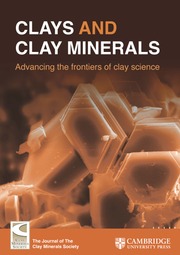No CrossRef data available.
Article contents
Effect of temperature on mineral evolution and adsorption of Eu3+ by bentonite in hyperalkaline conditions
Published online by Cambridge University Press: 18 November 2024
Abstract
Compacted bentonite, used as an engineering barrier for permanent containment of high-level radioactive waste, is susceptible to mineral evolution resulting in compromise of the expected barrier performance due to alkaline–thermal chemical interaction in the near-field. To elucidate the mineral-evolution mechanisms within bentonite and the transformation of the nuclide adsorption properties during that period, experimental evolution of bentonite was conducted in a NaOH solution with a pH of 14 at temperatures ranging from 60 to 120°C. The results showed that temperature significantly affects the stability of minerals in bentonite under alkali conditions. The dissolution rate of fine-grained cristobalite in bentonite exceeds that of smectite, with the phase-transition products of smectite being temperature-dependent. As the temperature rises, smectite experiences a three-stage transformation: initially, at 60°C, the lattice structure thins due to the collapse of the octahedral sheets; at 80°C, the lattice disintegrates and reorganizes into a loose framework akin to albite; and by 100°C, it further reorganizes into a denser framework resembling analcime. The adsorption properties of bentonite exhibit a peak inflection point at 80°C, where the dissolution of the smectite lattice eliminates interlayer pores and exposes numerous polar or negatively charged sites which results in a decrease in specific surface area and an increase in cation exchange capacity and adsorption capacity of Eu3+. This research provides insights into the intricate evolution of bentonite minerals and the associated changes in radionuclide adsorption capacity, contributing to a better understanding of the stability of bentonite barriers and the effective long-term containment of nuclear waste.
- Type
- Original Paper
- Information
- Copyright
- © The Author(s), 2024. Published by Cambridge University Press on behalf of The Clay Minerals Society



